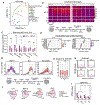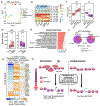Anp32e protects against accumulation of H2A.Z at Sox motif containing promoters during zebrafish gastrulation
- PMID: 38159623
- PMCID: PMC10922954
- DOI: 10.1016/j.ydbio.2023.12.010
Anp32e protects against accumulation of H2A.Z at Sox motif containing promoters during zebrafish gastrulation
Abstract
Epigenetic regulation of chromatin states is crucial for proper gene expression programs and progression during development, but precise mechanisms by which epigenetic factors influence differentiation remain poorly understood. Here we find that the histone variant H2A.Z accumulates at Sox motif-containing promoters during zebrafish gastrulation while neighboring genes become transcriptionally active. These changes coincide with reduced expression of anp32e, the H2A.Z histone removal chaperone, suggesting that loss of Anp32e may lead to increases in H2A.Z binding during differentiation. Remarkably, genetic removal of Anp32e in embryos leads to H2A.Z accumulation prior to gastrulation and developmental genes become precociously active. Accordingly, H2A.Z accumulation occurs most extensively at Sox motif-associated genes, including many which are normally activated following gastrulation. Altogether, our results provide compelling evidence for a mechanism in which Anp32e preferentially restricts H2A.Z accumulation at Sox motifs to regulate the initial phases of developmental differentiation in zebrafish.
Keywords: Anp32e; Chromatin accessibility; Embryonic development; H2A.Z; Neural crest; Sox.
Copyright © 2023 Elsevier Inc. All rights reserved.
Conflict of interest statement
Declarations of competing interest None.
Figures




Update of
-
Anp32e protects against accumulation of H2A.Z at Sox motif containing promoters during zebrafish gastrulation.bioRxiv [Preprint]. 2023 Dec 18:2023.12.18.572196. doi: 10.1101/2023.12.18.572196. bioRxiv. 2023. Update in: Dev Biol. 2024 Mar;507:34-43. doi: 10.1016/j.ydbio.2023.12.010. PMID: 38187710 Free PMC article. Updated. Preprint.
Similar articles
-
Anp32e protects against accumulation of H2A.Z at Sox motif containing promoters during zebrafish gastrulation.bioRxiv [Preprint]. 2023 Dec 18:2023.12.18.572196. doi: 10.1101/2023.12.18.572196. bioRxiv. 2023. Update in: Dev Biol. 2024 Mar;507:34-43. doi: 10.1016/j.ydbio.2023.12.010. PMID: 38187710 Free PMC article. Updated. Preprint.
-
Histone chaperone Anp32e removes H2A.Z from DNA double-strand breaks and promotes nucleosome reorganization and DNA repair.Proc Natl Acad Sci U S A. 2015 Jun 16;112(24):7507-12. doi: 10.1073/pnas.1504868112. Epub 2015 Jun 1. Proc Natl Acad Sci U S A. 2015. PMID: 26034280 Free PMC article.
-
Anp32e, a higher eukaryotic histone chaperone directs preferential recognition for H2A.Z.Cell Res. 2014 Apr;24(4):389-99. doi: 10.1038/cr.2014.30. Epub 2014 Mar 11. Cell Res. 2014. PMID: 24613878 Free PMC article.
-
Patterning chromatin: form and function for H2A.Z variant nucleosomes.Curr Opin Genet Dev. 2006 Apr;16(2):119-24. doi: 10.1016/j.gde.2006.02.005. Epub 2006 Feb 28. Curr Opin Genet Dev. 2006. PMID: 16503125 Review.
-
Mechanistic and structural insights into histone H2A-H2B chaperone in chromatin regulation.Biochem J. 2020 Sep 18;477(17):3367-3386. doi: 10.1042/BCJ20190852. Biochem J. 2020. PMID: 32941645 Review.
Cited by
-
CUT&Tag Applied to Zebrafish Adult Tail Fins Reveals a Return of Embryonic H3K4me3 Patterns During Regeneration.Res Sq [Preprint]. 2024 Apr 3:rs.3.rs-4189493. doi: 10.21203/rs.3.rs-4189493/v1. Res Sq. 2024. Update in: Epigenetics Chromatin. 2024 Jul 20;17(1):22. doi: 10.1186/s13072-024-00547-5. PMID: 38645155 Free PMC article. Updated. Preprint.
-
CUT&Tag applied to zebrafish adult tail fins reveals a return of embryonic H3K4me3 patterns during regeneration.Epigenetics Chromatin. 2024 Jul 20;17(1):22. doi: 10.1186/s13072-024-00547-5. Epigenetics Chromatin. 2024. PMID: 39033118 Free PMC article.
References
-
- Berta D, Kuisma H, Välimäki N, Räisänen M, Jäntti M, Pasanen A, Karhu A, Kaukomaa J, Taira A, Cajuso T, Nieminen S, Penttinen R-M, Ahonen S, Lehtonen R, Mehine M, Vahteristo P, Jalkanen J, Sahu B, Ravantti J, Mäkinen N, Rajamäki K, Palin K, Taipale J, Heikinheimo O, Butzow R, Kaasinen E, Aaltonen L, 2021. Deficient H2A.Z deposition is assoicated with genesis of uterine leiomyona. Nature 596, 398–403. - PubMed
-
- Bogdanovic O, Fernandez-Miñán A, Tena JJ, de la Calle-Mustienes E, Hidalgo C, van Kruysbergen I, van Heeringen SJ, Veenstra GJC, Gómez-Skarmeta JL, 2012. Dynamics of enhancer chromatin signatures mark the transition from pluripotency to cell specification during embryogenesis. Genome Res 22, 2043–2053. 10.1101/gr.134833.111 - DOI - PMC - PubMed
Publication types
MeSH terms
Substances
Grants and funding
LinkOut - more resources
Full Text Sources
Molecular Biology Databases
Miscellaneous

